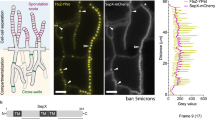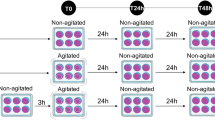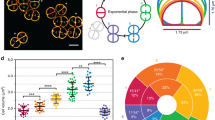Abstract
Three cohesion molecules have been discovered in the slime mould Dictyostelium discoideum1–4. Two of these molecules are involved in morphogenesis at the aggregation stage of the life cycle and thereafter, and may also provide an essential trigger for late gene expression5. The third glycoprotein 126 (gpl26) or contact site B, is present on axenically grown vegetative amoebae and persists to the aggregation stage where it is involved in the side-to-side cohesion of cells in aggregation streams1,4. It is puzzling that vegetative amoebae should possess a cohesion molecule because their solitary habit does not necessitate cohesion. However, they do need to adhere to the substratum and adhesion of bacteria to the cells is a prerequisite for phagocytosis. Vogel et al.6 have proposed that the same receptor is involved in phagocytosis and cohesion. It has also been suggested that contact site B-mediated cohesion is a trigger for development7. Using a specific antibody against gpl26, we now show that contact site B is a phagocytosis receptor. Furthermore, contact site B is involved in regulating the size of aggregates formed during morphogenesis; it also seems to be involved in cell–substratum adhesion but is not a developmental trigger.
This is a preview of subscription content, access via your institution
Access options
Subscribe to this journal
Receive 51 print issues and online access
$199.00 per year
only $3.90 per issue
Buy this article
- Purchase on Springer Link
- Instant access to full article PDF
Prices may be subject to local taxes which are calculated during checkout
Similar content being viewed by others
References
Beug, H., Gerisch, G., Kempff, S., Riedel, B. & Cremer, G. Expl Cell Res. 63, 147–158 (1970).
Beug, H., Katz, F. E. & Gerisch, G. J. Cell Biol. 56, 647–658 (1973).
Steinemann, C. & Parish, R. W. Nature 286, 621–623 (1980).
Chadwick, C. M. & Garrod, D. R. J. Cell Sci. 60, 251–266 (1983).
Mangiarotti, G., Ceccarelli, A. & Lodish, H. F. Nature 301, 616–618 (1983).
Vogel, G., Thilo, L., Schwarz, H. & Steinhart, R. J. Cell Biol. 86, 456–465 (1980).
Marin, F. T., Goyette-Boulay, M. & Rothman, F. G. Devl Biol. 80, 301–312 (1980).
Eckhardt, A. E., Hayes, C. E. & Goldstein, L. J. Analyt. Biochem. 73, 192–197 (1976).
Glynn, P. J. Cytobios 30, 153–166 (1981).
Swan, A. P. & Garrod, D. R. Expl Cell Res. 93, 479–484 (1975).
Garrod, D. R. Expl Cell Res. 72, 588–591 (1972).
Garrod, D. R. & Ashworth, J. M. J. Embryol. exp. Morph. 28, 463–479 (1972).
Sussman, M. in Methods in Cell Physiology Vol. 2, Ch. 14 397–410 (Academic, New York, 1966).
Author information
Authors and Affiliations
Rights and permissions
About this article
Cite this article
Chadwick, C., Ellison, J. & Garrod, D. Dual role for Dictyostelium contact site B in phagocytosis and developmental size regulation. Nature 307, 646–647 (1984). https://doi.org/10.1038/307646a0
Received:
Accepted:
Issue Date:
DOI: https://doi.org/10.1038/307646a0
This article is cited by
-
Cell adhesion in the life cycle ofDictyostelium
Experientia (1995)
Comments
By submitting a comment you agree to abide by our Terms and Community Guidelines. If you find something abusive or that does not comply with our terms or guidelines please flag it as inappropriate.



